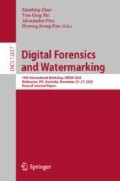Abstract
Nowadays, Convolutional Neural Network (CNN) based steganalytic schemes further improves the detection ability of the steganalyzer comparing with feature based schemes. Besides steganalysis, CNN model can also be used in steganography. Inheriting the mechanism from adversarial attack to CNN model, adversarial embedding is a kind of steganographic scheme that exploits the knowledge of CNN-based steganalyzer. Adversarial embedding can effectively improve security performance of typical adaptive steganographic schemes. In this paper, we propose a novel adversarial embedding scheme for steganography named as Segmented Adversarial Embedding (SAE). The core of SAE is separating the embedding process into several partial embedding processes and performing adversarial embedding in each segment. In each partial embedding process, there is an individual CNN model corresponding to the current embedding stage. In the embedding process, a novel scheme is applied in the cost adjustment. Comparing with the adjustment scheme that utilizes the gradient sign, the new scheme also takes the gradient magnitude into account, which further makes use of the gradient information. Besides the typical implementation of SAE, we also develop a simplified variant with lower complexity. The evaluations on different kinds of steganalyzer prove that SAE is effective to improve the performance of existing steganographic scheme.
X. Zhao—This work is supported by the State Grid Corporation of China Project (5 700-202018268A-0-0-00).
Access this chapter
Tax calculation will be finalised at checkout
Purchases are for personal use only
References
Bernard, S., Bas, P., Klein, J., Pevny, T.: Explicit optimization of min max steganographic game. IEEE Trans. Inf. Forensics Secur. 16, 812–823 (2021)
Bernard, S., Pevnỳ, T., Bas, P., Klein, J.: Exploiting adversarial embeddings for better steganography. In: Proceedings of the ACM Workshop on Information Hiding and Multimedia Security, pp. 216–221. ACM (2019)
Boroumand, M., Chen, M., Fridrich, J.: Deep residual network for steganalysis of digital images. IEEE Trans. Inf. Forensics Secur. 14(5), 1181–1193 (2019)
Butora, J., Fridrich, J.: Steganography and its detection in JPEG images obtained with the “TRUNC” quantizer. In: ICASSP 2020–2020 IEEE International Conference on Acoustics, Speech and Signal Processing (ICASSP), pp. 2762–2766 (2020)
Cogranne, R., Giboulot, Q., Bas, P.: Alaska#2 steganalysis challenge. http://alaska.utt.fr
Denemark, T., Fridrich, J.: Improving steganographic security by synchronizing the selection channel. In: Proceedings of the 3rd ACM Workshop on Information Hiding and Multimedia Security, IH&MMSec 2015, pp. 5–14. ACM, New York (2015)
Filler, T., Judas, J., Fridrich, J.: Minimizing additive distortion in steganography using syndrome-trellis codes. IEEE Trans. Inf. Forensics Secur. 6(3), 920–935 (2011)
Fridrich, J., Filler, T.: Practical methods for minimizing embedding impact in steganography. In: Delp III, E.J., Wong, P.W. (eds.) Security, Steganography, and Watermarking of Multimedia Contents IX, vol. 6505, pp. 13–27. International Society for Optics and Photonics, SPIE (2007)
Goodfellow, I., Shlens, J., Szegedy, C.: Explaining and harnessing adversarial examples. arXiv preprint arXiv:1412.6572 (2014)
Guo, L., Ni, J., Su, W., Tang, C., Shi, Y.: Using statistical image model for JPEG steganography: Uniform embedding revisited. IEEE Trans. Inf. Forensics Secur. 10(12), 2669–2680 (2015)
Holub, V., Fridrich, J.: Digital image steganography using universal distortion. In: Proceedings of the First ACM Workshop on Information Hiding and Multimedia Security, pp. 59–68. ACM (2013)
Holub, V., Fridrich, J.: Low-complexity features for JPEG steganalysis using undecimated DCT. IEEE Trans. Inf. Forensics Secur. 10(2), 219–228 (2015)
Kodovsky, J., Fridrich, J., Holub, V.: Ensemble classifiers for steganalysis of digital media. IEEE Trans. Inf. Forensics Secur. 7(2), 432–444 (2012)
Kouider, S., Chaumont, M., Puech, W.: Adaptive steganography by oracle (ASO). In: 2013 IEEE International Conference on Multimedia and Expo (ICME), pp. 1–6, July 2013
Li, B., Wang, M., Li, X., Tan, S., Huang, J.: A strategy of clustering modification directions in spatial image steganography. IEEE Trans. Inf. Forensics Secur. 10(9), 1905–1917 (2015)
Ma, S., Zhao, X., Liu, Y.: Adaptive spatial steganography based on adversarial examples. Multimed. Tools Appl. 78(22), 32503–32522 (2019). https://doi.org/10.1007/s11042-019-07994-3
Mo, H., Song, T., Chen, B., Luo, W., Huang, J.: Enhancing jpeg steganography using iterative adversarial examples. In: 2019 IEEE International Workshop on Information Forensics and Security (WIFS), pp. 1–6 (2019)
Tan, M., Le, Q.V.: EfficientNet: rethinking model scaling for convolutional neural networks. arXiv preprint arXiv:1905.11946 (2019)
Tang, W., Li, B., Tan, S., Barni, M., Huang, J.: Cnn-based adversarial embedding for image steganography. IEEE Trans. Inf. Forensics Secur. 14(8), 2074–2087 (2019)
Zhang, W., Zhang, Z., Zhang, L., Li, H., Yu, N.: Decomposing joint distortion for adaptive steganography. IEEE Trans. Circ. Syst. Video Technol. 27(10), 2274–2280 (2017)
Zhang, Y., Zhang, W., Chen, K., Liu, J., Liu, Y., Yu, N.: Adversarial examples against deep neural network based steganalysis. In: Proceedings of the 6th ACM Workshop on Information Hiding and Multimedia Security, pp. 67–72. ACM (2018)
Author information
Authors and Affiliations
Corresponding author
Editor information
Editors and Affiliations
Rights and permissions
Copyright information
© 2021 Springer Nature Switzerland AG
About this paper
Cite this paper
Ma, S., Zhao, X. (2021). Generating JPEG Steganographic Adversarial Example via Segmented Adversarial Embedding. In: Zhao, X., Shi, YQ., Piva, A., Kim, H.J. (eds) Digital Forensics and Watermarking. IWDW 2020. Lecture Notes in Computer Science(), vol 12617. Springer, Cham. https://doi.org/10.1007/978-3-030-69449-4_6
Download citation
DOI: https://doi.org/10.1007/978-3-030-69449-4_6
Published:
Publisher Name: Springer, Cham
Print ISBN: 978-3-030-69448-7
Online ISBN: 978-3-030-69449-4
eBook Packages: Computer ScienceComputer Science (R0)

